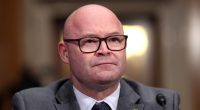
We savers love an easy-access account. There is an incredible £910 billion sitting in them — over three times the £269 billion in fixed-rate bonds.
It may be tempting to stick with an account that lets you access your money at any time, but now is the perfect time to consider a fixed-rate bond.
Rates on easy-access accounts are starting to fall, but those on fixed-rate bonds are still rising — but likely not for much longer, so act while you can.
In its forecast last week, the Office for Budget Responsibility predicted inflation would fall below the Bank of England’s target rate of 2 per cent within a few months — nearly a whole year earlier than forecast six months ago.
As inflation eases, it is likely interest rates will do too. Money markets expect the Bank of England base rate to plunge this year from 5.25 per cent to 4.2 per cent in the last quarter of 2024.


Time to fix? The rates on easy-access accounts are now starting to fall, but those on fixed-rate bonds are still rising – but for how long?
That makes easy-access account rate cuts more likely. Four providers — Paragon Bank, Close Brothers Savings, Virgin Money and Hampshire Trust Bank — have already pulled their top rates.
But fixed-rate bond rates have been edging up as competition among providers intensifies.
While the top easy-access rate is 5.08 per cent from Charter Savings Bank; you can get a higher rate on a one-year bond at 5.28 per cent from SmartSave.
The top rate for two years is now 5 per cent after rises from Hampshire Trust Bank and Close Brothers. Hodge Bank also pays 5 per cent and others may soon join in.
Taking out a longer-term fix may be hard, as your money is locked away until the end of the term.
But if your plan is to take out a one-year bond now then another when it matures in 12 months’ time, you could be better off going for a two-year bond.
For if you earn 5.25 per cent now for a year, you will need to find a new one-year bond paying at least 4.75 per cent next year to match the top 5 per cent two-year bond available now. Rates are likely to fall below this in a year’s time.
Five-year fixed-rate accounts are paying less than shorter-term rates and you may baulk at tying your money up this long.
The top rate is 4.54 per cent from Hampshire Trust Bank or 4.53 per cent from both Shawbrook and Close Brothers.
But if you know you won’t need your cash, it could prove a good bet as rates are likely to fall.
A cash Isa can also be a good option for a longer-term fix, as you can close an Isa whenever you choose and get your money back. You may miss out on interest or have to pay a penalty, but you can get it in an emergency.
Rates on five-year fixes are lower with Isas: you can get just over 4 per cent from Close Brothers, United Trust Bank, Secure Trust, Zopa along with Principality and Nottingham building societies.
If you do opt for a bond over one-year, remember to pick one that pays interest and lets you withdraw it at the end of every year, rather than one that pays out the lot at the end.
If you receive all of the interest at once, it counts towards your personal savings allowance in that tax year.
This allowance permits you to earn up to £1,000 in interest if you’re a basic-rate taxpayer, £500 if you’re higher rate and you have no allowance if an additional rate taxpayer. Everything you earn above your limit is taxed at your income tax rate.
If you get all your interest at once, you are more at risk of breaching your personal savings allowance than if it is drip fed each year of your account’s term.
NS&I to offer ‘mid-market rate’ bonds
Good news for savers — National Savings & Investments (NS&I) is launching a three-year bond next month to be known as the British Savings Bond.
NS&I has yet to announce the rate or when it will go on sale, revealing only that it will be ‘early April’.
But my guess is that it will be in the first week, to coincide with the beginning of its new financial year on April 1.
It has also confirmed the rate will be priced at ‘mid-market’ to those paid by other providers.
The best rate now is 4.65 per cent fixed for three years (Hampshire Trust Bank) but they are as low as 3.65 per cent or 3.7 per cent (Co-op Bank and Santander).
Therefore, to be in the middle of the pack, I think NS&I would go for a rate of around 4.15 per cent.
The rate should certainly be better than that offered to the 400,000 savers in its three-year Guaranteed Bonds.
These have not been on sale since September 2019 and the rate on such bonds is a lowly 3.45 per cent after it was chopped from 5.8 per cent at the start of this year.
The big advantage of NS&I is that all your money there is guaranteed by the Government.
But be warned, the way the bonds are structured puts you in danger of having to pay tax on your interest.









